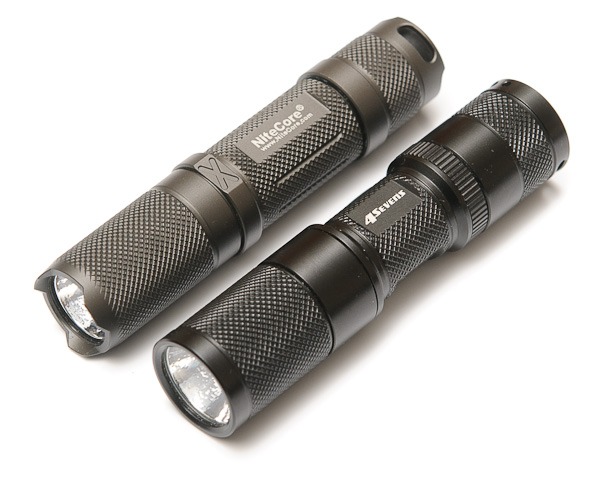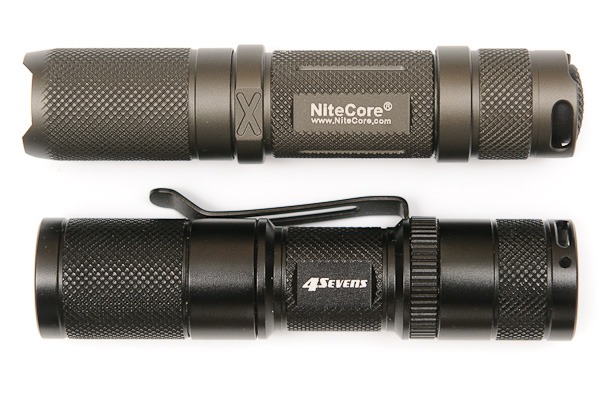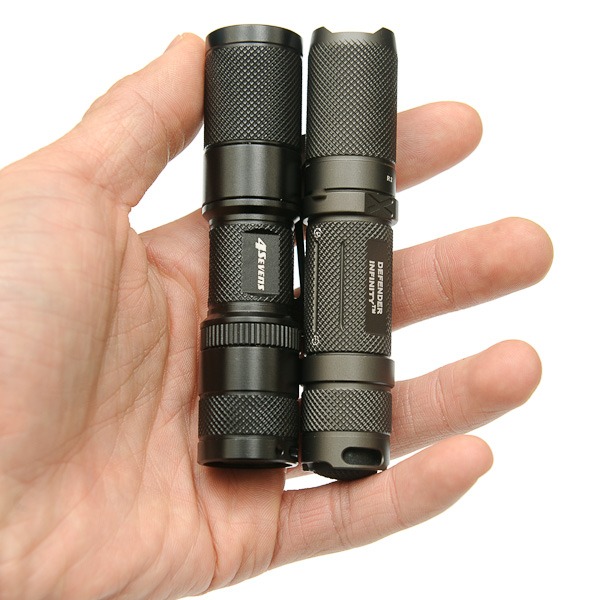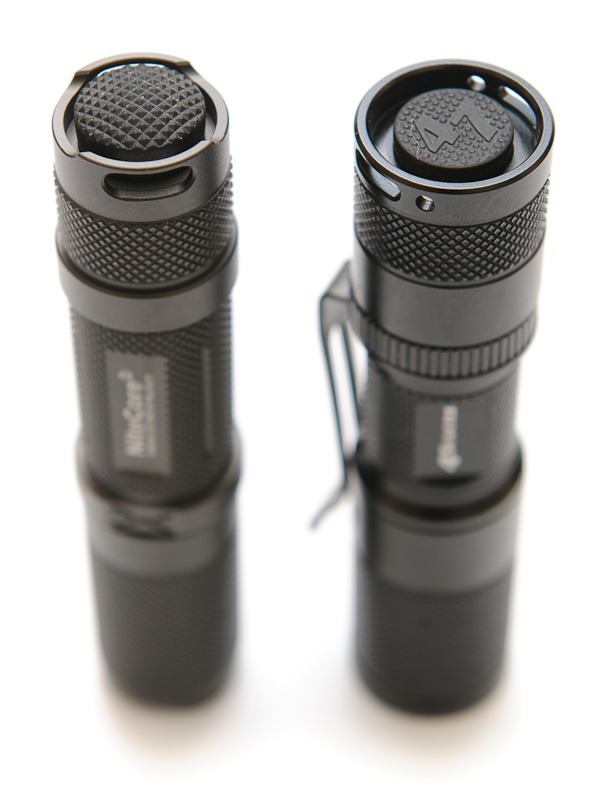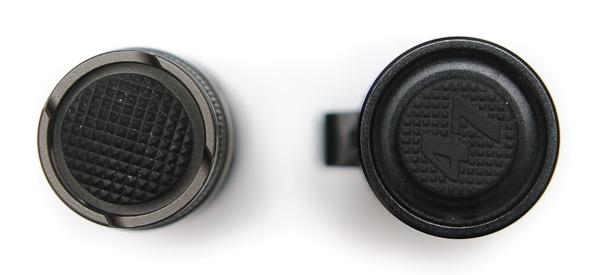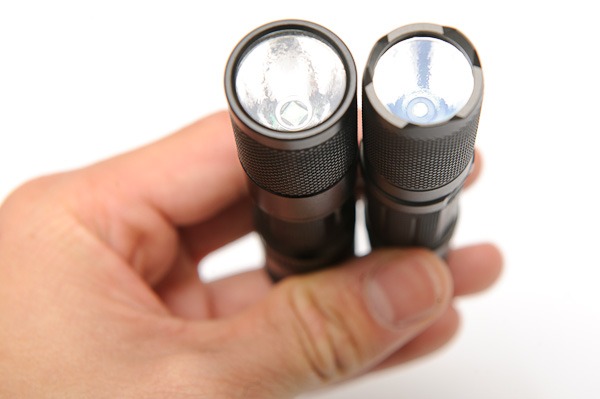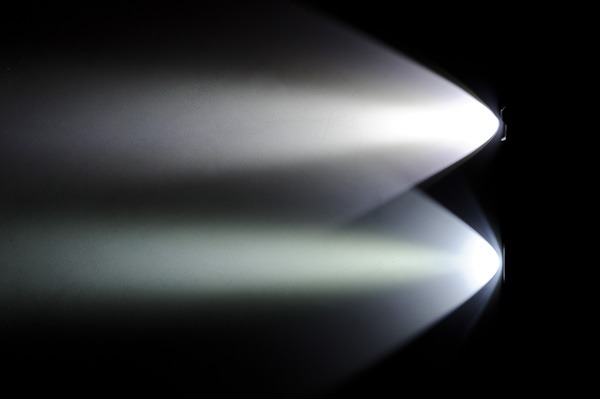If you're a regular reader of www.ishootshows.com, you've seen my individual reviews of the Nitecore Defender Infinity and 4Sevens Quark AA. But, if you're read both reviews, you may also be curious about comparisons between these two AA battery-powered LED flashlights.
While they share a lot of the superficial specifications, in use, these are two different tools. Each has their on strengths and weakness. My full comparison review after the jump.
Apples & Oranges
The big distinction between these lights is there switch design – a tactical switch on the Nitecore Defender Infinity that allows for a momentary-on activation, and a “standard” reverse clicky on the 4Sevens Quark that requires a full-press to turn on. There are pros and cons to these two lights and their ease of use – relatively speaking, comparing two lights like this is pretty “apples and oranges.”
While it would be a more natural fit to compare two tactical lights or two standard lights, just due to this difference in activation, the Nitecore and 4Sevens lights are the torches I have at hand.
It's worth posting the story of how I came to own these lights, just for reference, which I originally posted in the dedicated review of the Nitecore Defender Infinity:
So last Christmas, I bought my brother a Quark AA LED flashlight, thinking that it’d be a good little tool for any photographer and especially a music photographer. I also bought one for myself for the same reason. So, imagine my surprise when I open up one of Chris’s gifts for me – it was the Nitecore Defender Infinity LED flashlight, another tactical light very similar to the Quark AA!
Design
While these lights share a common power source, there are several distinct differences in the design of the Nitecore Defender Infinity and the 4Sevens Quark AA.
In The Hand
In the hand, the lights do have a distinctly different feel. While the Nitecore Defender Infinity features a relatively uniform diameter, the Quark AA has a more pronounced difference between the head and tail and the body of the light.
In use, what this means is a more streamlined feel to the Nitecore, while the 4Sevens's design features a tapered midsection for easy holding.
Anti-Roll
These two lights accomplish anti-roll features in different ways. With the 4Sevens Quark AA, the anti-roll safety is accomplished by its clip. With the Nitecore DI, the ant-roll feature is realized by a flattened, raised portion of the casing.
Clip
Aside from the difference in the bodies of these LED flashlights, one key element is the inclusion of a clip on the Quark AA. For anyone looking to carry these lights, in a bag or on one's person, the clip is a very nice addition, as it ensures the light won't be rolling around in a pocket or bag. Though, I should add that thanks to the grade-III hard-anodization, both lights can certainly take a few scrapes.
Tailcap Button – Tactical vs Standard
For one, the interface of these two LED flashlights differs, with the Nitecore featuring a “standard” tactical interface and the 4Sevens Quark standard, “reverse clicky” operation. What this means is that the Nitecore can be activate with a half-depression of the tailcap button, while the 4Sevens Quark AA must be fully depressed to turn the light on.
Unlike the Nitecore, it's almost impossible to accidentally activate the Quark AA, but this also means that the Quark takes all the more effort to use on a regular basis.
Lens Coating
Overall, the 4Sevens Quark AA seems to feature a better anti-reflective coating than the Nitecore Defender Infinity. Overall clarity of the Quark glass lens features less reflection than the Nitecore light. However, though there's a stark difference between the two as photographed, in practical use there's essentially no difference in the quality of light they throw.
The 4Sevens Quark AA features an impact-resistant glass lens with a dual-coating – a sapphire coating on the outside for hardness and an anti-reflective coating on the inside for optimal efficiency.
By the specs, the Nitecore Defender Infinity features an anti-reflective coating, though it seems as though their AR coating is less effective than that employed by 4Sevens.
Interface & Operation
Aside from the difference in the tailcap button, the two lights do feature different interfaces for changing modes. Both utilize the front bezel for their major mode settings, with loosened and fully-tightened settings available. For both lights, the tightened mode is set to the high mode, while the loosened setting is set to the custom/variable mode.
The main difference between the Defender Infinity and Quark AA is the way one changes between brightness settings in the variable mode.
Nitecore Intereface
The Nitecore Defender Infinity features a twist-based interface to change between modes, quickly loosening and then tightening the bezel, or vice versa. In the high mode (tightened bezel), qickly loosening Nitecore's bezel and then tightening it again switches between the standard high mode and strobe function. In the variable mode (loosened bezel), tightening and then loosening the Nitecore's bezel starts ramping the light from low to high. Repeating the bezel tweak reverses the ramping function.
There are pros and cons to Nitecore's interface. On the one hand, this system makes it impossible to accidentally enter the annoying and almost entirely useless strobe function. This is a huge bonus for most users. On the other hand, the twist interface is relatively slow.
For someone who wants primarily high and low functions, and again, without the annoying strobe function, the interface of the Nitecore is perfect.
4Sevens Interface
In contrast to the Nitecore DI's interface, the Quark AA relies on a half-press input to change between modes, made possible by the reverse clicky tail button.
In the high mode, a half-press changes to the strobe. In the variable mode, a half-press will cycle through low-medium-high brightnesses and then strobe and beacon modes.
Since all it takes to change modes is a half-press, this is both good and bad. For any user who needs to change modes often, the Quark's interface is much faster than the Nitecore's. On the flipside, it's also easier to accidentally change into one of the ridiculous strobe or beacon modes, so you've got to pick your poison.
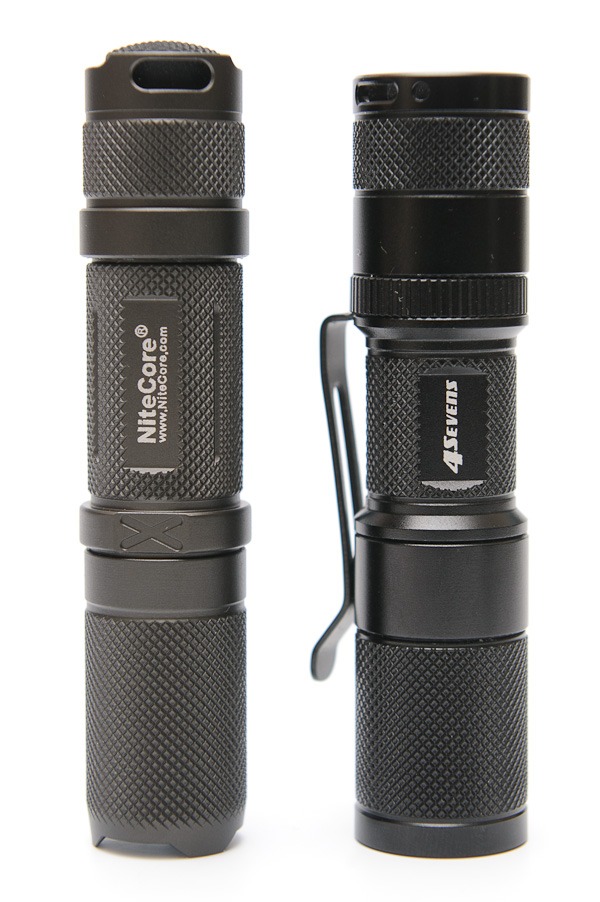
Again, the interface of these lights is relatively apples and oranges when it comes to flashlights. If the tactical switch of the Nitecore appeals but you're interested in the options of the Quark AA, 4Sevens does make the Quark AA Tactical. The Quark AA Tactical features a tactical button and interface similar to the main two-mode use of the Nitecore, but with the option to program a custom level like the Quark AA. Of course, the tactical Quark also includes a pocket clip and the sweet “moonlight” mode.
Output Modes
As mentioned above, one of the main differences between the Nitecore DI and the 4Sevens Quark AA is their approach to the variable brightness settings.
When you enter the custom mode on the Nitecore, the light slowly starts to ramp up the beam brightness from low to high. Due to this operation, it's essentially possible to stop the ramping set any level of brightness between low and high.
With the 4Sevens Quark AA, there are four levels of brightness – the expected low, medium, and high modes, as well as an ultra-low “moonlight” mode of just 0.4 lumens.
At their highest output, the brightness is pretty much identical for all intents and purposes.
Moonlight Mode Advantage
When compared to the 4 lumens low output of the Quark AA and the 3 lumens output low of the Nitecore Defender Infinity, the Quark's moonlight mode is much, much dimmer. In fact, it's a fantastic feature, especially when only needing light to read something or work on a task at hand.
The inclusion of this super-low setting alone is enough to make the Quark super handy if you have need for this kind of output.
Beam Pattern
Overall, the beam pattern is very similar, with a focused spot and a relative degree of flood.
As evidenced by the photo below, the Nitecore Defender Infinity (top) features a very slightly broader spot with a slightly broader spill area compared to the 4Sevens Quark AA. At distance, the Nitecore's spot is slightly more diffuse than that of the 4Seven's, but overall the difference is pretty minimal. In practice, the difference between the output of the two is essentially identical.
One thing to note is due to the crenellated bezel of the Nitecore, there is a hint of the triangular formation in the outer edge of the spill beam. It's only really noticeable when you're doing dorky things like looking at the beam pattern on a white wall – for all actual use of the Nitecore Infinity Defender, it's a non-issue.
Beam Color
In terms of the quality of light, the two lights also differ in the specific color temperature of their LED emitters. Overall, the R5 Cree emitter of the Quark AA features a slightly cool, green tint, while the Nitecore's R2 emitter has a very slightly magenta tint. These differences are only really noticeable when using the lights side-by-side.
For normal use, there is no practical difference between the output of these lights in terms of color, quality, or throw.
Summary
Both the Nitecore Defender Infinity and the 4Seven's Quark AA are excellent lights. At their core, they offer almost identical performance with some key differences in their execution. Ultimately, neither light is really better than the other, but which one may be better for you depends on your use and expectation.
For most users, the quick half-press activation and tactical clicky of the Nitecore Defender Infinity will make it the faster light for general use. For users who will need variable brightness, the quick-switching of the Quark AA makes for an easier interface, albeit with the risk of running into the “disco” strobe and beacon modes.
In terms of the design, the Nitecore is undeniably slicker and, dare I say, sexier, while the 4Sevens light has the benefit of a clip. and a tapered middle section for easy holding between one's fingers. The build quality of both is excellent.
I'd have to say that you can't go wrong with either light.
Again, if the tactical nature of the Nitecore appeals but you find yourself preferring the option of a clip and the ultra-low “moonlight” mode of the 4Sevens light, definitely check out the 4Sevens' Quark AA Tactical, which combines all these features.
Buy Yourself Something Nice
Simply clicking through either B&H or Amazon.com here for your purchases helps me bring you free content like these 6-tips for the new concert photographer, and naturally it doesn’t cost you a cent more. If you do grab some gear, drop me a line! I’d love to hear about what you picked up.

